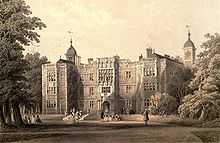James Holland (artist)


James Holland (18 October 1799 – 12 December 1870)[1] was an English painter of flowers, landscapes, architecture and marine subjects, and book illustrator. He worked in both oils and watercolours and was a member of the Royal Watercolour Society.[2]
Life and work
Holland was born in Burslem, Staffordshire, where his father and other members of his family were employed at the pottery works of William Davenport in Longport. James was himself employed there, from the age of 12, for 7 years, painting flowers on pottery and porcelain. In 1819, he came to London where he continued to work as a pottery painter, but also gave lessons in drawing landscapes, architecture, and marine subjects.
He first exhibited at the Royal Academy in 1824 and in 1830 visited France and made studies of its architecture. In 1823 he exhibited a picture of 'London from Blackheath'. In 1835 he became an associate exhibitor of The Society of Painters in Water-colours, but he left the society in 1843, and joined the Society of British Artists, of which he remained a member until 1848. He rejoined the Watercolour Society in 1856, and was elected a full member two years later.
Holland did a great deal of drawing for the illustrated annuals of the day, and for this purpose visited Venice, Milan, Geneva, and Paris in 1836, and Portugal in 1837. His paintings of Portugal were published in the book, "The Tourist in Portugal".[3] In 1839 he exhibited a painting of Lisbon at the Royal Academy. In 1845 he went to Rotterdam, Portugal again in 1847, in 1850 to Normandy and North Wales, in 1851 again to Geneva, and in 1857 again to Venice.
In the course of his life he exhibited, in addition to his contributions to the Watercolour Society, 32 pictures at the Royal Academy, 91 at the British Institution, and 108 at the Society of British Artists. Though generally classed as a water-colour painter, he was equally skilful in oils. He was one of the finest colourists of the English school, and his pictures, especially those of Venice, though neglected in his lifetime, became much sought after in the years after his death. He appears to have ceased to exhibit in 1857.
One of Holland's pupils was topographical artist Frank Dillon (1823–1909) known especially for his paintings of Egypt.
References
- ↑ Biography (Answers.com).
- ↑
 Lee, Sidney, ed. (1891). "Holland, James". Dictionary of National Biography 27. London: Smith, Elder & Co. p. 146–7.
Lee, Sidney, ed. (1891). "Holland, James". Dictionary of National Biography 27. London: Smith, Elder & Co. p. 146–7. - ↑ Harrison, W. H. & Holland, J. The tourist in Portugal (London: Robert Jennings, 1839).
Further reading
- Roget, John Lewis. A history of the 'Old water-colour' society (London, New York: Longmans, Green and co., 1891) pp. 249–51.
- Steve Bond. James Holland: The Forgotten Artist (Churnet Valley Books, 1999).
External links
| Wikimedia Commons has media related to James Holland (artist). |
- James Holland online (ArtCyclopedia)
- Artist of the month, June 2006 (Lady Lever Art Gallery, Liverpool)
- Paintings by James Holland (Bridgeman Art Library]
- Watercolours by Holland (Guy Peppiatt Fine Art)
- Moorish castle, Mafra (1837 watercolour - V&A)
- Canal at Venice (Watercolour - V&A)
- The coast at Sanpierdarena, near Genoa (1851 watercolour - Christie's)
|